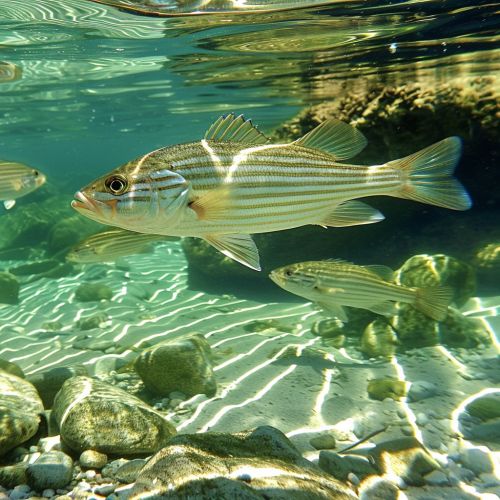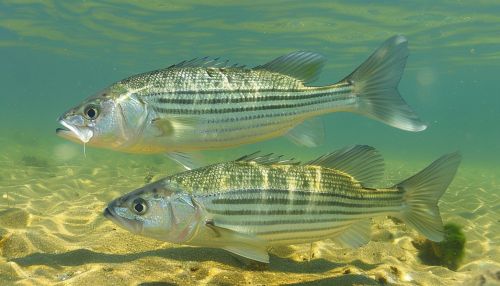Morone saxatilis
Description


Morone saxatilis, commonly known as the striped bass, is a species of anadromous fish found along the Atlantic coast of North America. It is a member of the family Moronidae and is highly valued both as a commercial and recreational fish. The species is known for its distinctive horizontal stripes running along its body, which give it its common name.
Taxonomy and Classification
The striped bass belongs to the genus Morone within the family Moronidae. The species was first described by the French naturalist Georges Cuvier in 1829. It is closely related to other members of the genus, such as the white bass (Morone chrysops) and the yellow bass (Morone mississippiensis).
Morphology and Anatomy
Striped bass are characterized by their elongated bodies and silvery coloration with seven to eight dark horizontal stripes along their sides. They have two dorsal fins: the first is spiny, and the second is soft-rayed. Adult striped bass can reach lengths of up to 1.8 meters (6 feet) and weights exceeding 56 kilograms (125 pounds), although individuals of this size are rare.
The species exhibits sexual dimorphism, with females generally growing larger than males. The lateral line system is well-developed, aiding in the detection of prey and navigation in murky waters.
Distribution and Habitat
Striped bass are native to the Atlantic coast of North America, ranging from the St. Lawrence River in Canada to the St. Johns River in Florida. They are also found in the Gulf of Mexico and have been introduced to various inland water bodies, including reservoirs and lakes.
The species is anadromous, meaning it migrates from saltwater to freshwater to spawn. Spawning typically occurs in rivers and estuaries during the spring. Juveniles spend their early life stages in freshwater before migrating to coastal waters.
Life Cycle and Reproduction
Striped bass reach sexual maturity at different ages depending on their environment. In general, males mature at 2-3 years of age, while females mature at 4-6 years. Spawning occurs in freshwater rivers and estuaries, where females release large quantities of eggs that are fertilized externally by males.
The eggs are buoyant and drift with the current until they hatch into larvae. The larvae then develop into juveniles, which remain in freshwater habitats for several months before migrating to the ocean.
Diet and Feeding Behavior
Striped bass are opportunistic predators with a diet that varies depending on their life stage and habitat. Juveniles primarily feed on zooplankton and small invertebrates, while adults consume a wide range of prey, including fish, crustaceans, and mollusks.
The species is known for its aggressive feeding behavior and often forms large schools to hunt. They use their keen sense of smell and lateral line system to detect prey in low-visibility conditions.
Ecological Role
As apex predators, striped bass play a crucial role in maintaining the balance of marine and freshwater ecosystems. They help control the populations of smaller fish and invertebrates, which can have cascading effects on the food web.
The species is also an important indicator of environmental health, as their presence and population dynamics can reflect changes in water quality and habitat conditions.
Conservation and Management
Striped bass populations have experienced significant fluctuations due to overfishing, habitat loss, and pollution. In the 1980s, the species faced severe declines, prompting the implementation of strict management measures, including fishing quotas, size limits, and habitat restoration efforts.
These measures have been largely successful, leading to the recovery of many striped bass populations. However, ongoing challenges such as climate change, water pollution, and habitat degradation continue to pose threats to the species.
Economic and Recreational Importance
Striped bass are highly valued for their commercial and recreational significance. The species supports a lucrative fishing industry, with commercial catches primarily occurring along the Atlantic coast. Recreational fishing for striped bass is also popular, attracting anglers from around the world.
The species is prized for its fighting ability and culinary qualities, making it a sought-after target for sport fishing. Many coastal communities rely on striped bass fisheries for economic and cultural reasons.
Research and Studies
Ongoing research on striped bass focuses on various aspects of their biology, ecology, and management. Studies have examined their migratory patterns, reproductive biology, and responses to environmental changes. Advances in technology, such as acoustic tagging and genetic analysis, have provided new insights into the species' behavior and population dynamics.
Research findings are used to inform management practices and conservation strategies, ensuring the sustainable use of striped bass populations.
See Also
- Anadromous Fish
- Moronidae
- Georges Cuvier
- White Bass
- Yellow Bass
- Atlantic Coast of North America
- Estuary
- Zooplankton
- Apex Predator
- Climate Change
